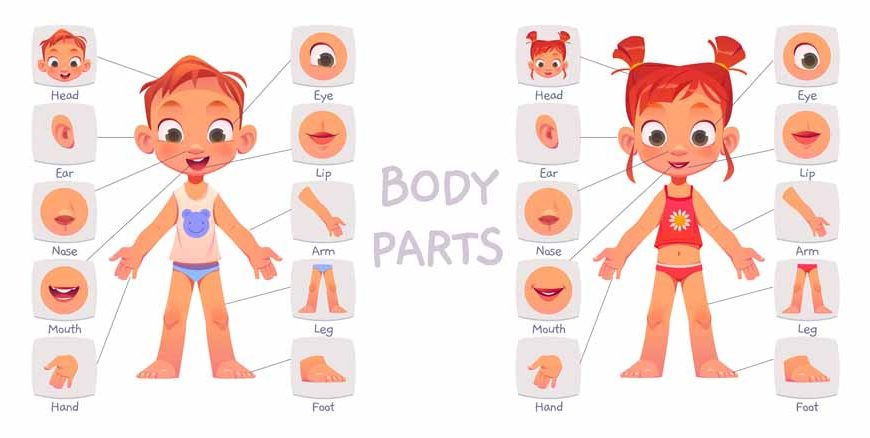Children are curious and inquisitive by nature and love learning about new things. In fact, preschoolers are very open to exploring and understanding new concepts. They love hearing and later reading facts about the human body like the human body structure, human body systems and human body organs. In fact when a child first begins to talk, one of the first things they learn is the human body parts name. The human body structure is very complex and its various capabilities and aspects are almost unimaginable. So, let’s look at some fun facts about the human body that are sure to keep your preschooler interested and help them to understand it better.
15 Interesting and Fun Facts About the Human Body
- The human body sheds skin cells at the amazing rate of about 50,000 cells per minute. What is even more fascinating is that it is these dead skin cells that we see as dust in the air. Believe it or not, human beings actually lose about 4 kilograms of skin cells every year.
- Your nose has many responsibilities to perform — it helps you to breathe, smell good fragrances and bad odours and according to scientists the nose has the ability to recognise around a trillion different scents. The nose also cleans the air you breathe. Pollen and dust particles are caught in the fine hair of the nose which prevents you from breathing them in. These particles get expelled from your nose when you sneeze and a sneeze can travel at a speed of 160 km/hour.
- An adult human being has 206 bones in their body while a new born baby has more than 300 bones. If you are wondering what happens to these bones, they actually fuse together and form a more stable and stronger skeletal system. These bones give the human body structure and also help to support the body.
- The human heart is roughly the size of a juice box and weighs about 300 grams in a male adult, 250 grams in a female adult and about 100 grams in a baby. A human heart beats approximately 100000 times in a day, 36500000 times in a year and and in an average lifespan beats more than three billion times. It is one of the most powerful human body organs and the blood pressure produced by the heart can squirt blood upto 9 metres in the air.
- The brain of a human being is more than thrice the size of the brain of other animals. Not only is the human brain bigger than that of smaller mammals, it’s also bigger than other animals of the same size. Surprisingly, the human brain is sometimes more active when you are fast asleep than when you are awake. The human brain utilises more than 25 percent of the oxygen used by a human being.
- In a human being’s body, the largest muscle is in the buttocks and is called the gluteus maximus while the smallest muscle in a human body is the stapedius which is situated in the middle ear and is only 1.27 mm long.
- Believe it or not but 99 percent of the DNA in all human beings is the same and if you line up all the DNA of all the cells of a human being, you could spread it to the moon and back to the earth close to 3000 times.
- An infant only blinks once or twice in a minute as compared to an adult who blinks about 10 times every minute.
- The word ‘muscle’ is derived from Latin and means ‘little mouse’. This is because the ancient Romans believed that bicep muscles when flexed looked like a little mouse.
- One of the most complex human body systems, the nervous system of the human body has over 7 trillion nerves and Information travels along these nerves at about 400 km/ hour.
- Human beings have about 60,000 miles of blood vessels in their body and if you were to line them up, an adult human being’s blood vessels could go around the equator 4 times.
- The maximum growth in a human body takes place in the first two years of life. The human body doesn’t see this much growth for the rest of its life.
- It is common knowledge that all human beings have their own unique set of fingerprints, but what is amazing is that they also have unique tongue prints.
- An average human being has about 67 different kinds of bacteria in their belly button alone. That’s a whole lot of bacteria for such a small navel.
- An average human being is capable of surviving for about 3 minutes without an oxygen supply, 3 to 5 days without water and around forty days without food.
There are a plethora of other interesting facts about the human body, some of which are quite unbelievable and others that are just fun. Knowing these facts help children in developing a better perspective of their body and the way they think about their body. It also generates an interest in them and they want to explore and understand the various parts of their body and how they develop. How often is it that we actually stop and think about how extraordinary our bodies really are? The complex human body structure and systems have a million things happening simultaneously every second, and they all work together to keep us healthy and alive. The human body is truly amazing! The way it functions is incredible and we very often tend to take it for granted. It is now time to explore and appreciate all that our body does for us each day. In case you are looking for more fun and interesting facts about the human body that you would like to share with your preschooler, visit the EuroKids website for a whole lot of information.
















